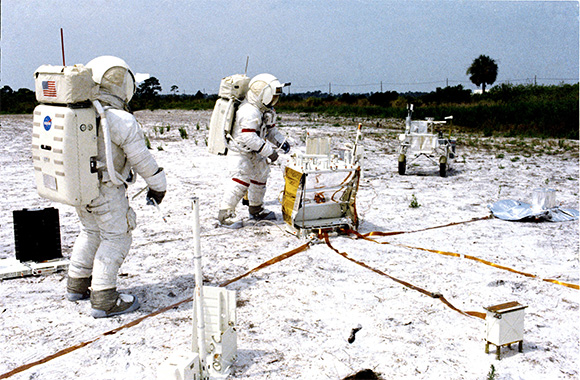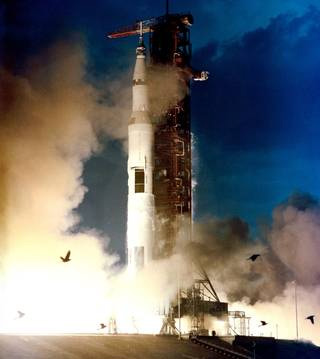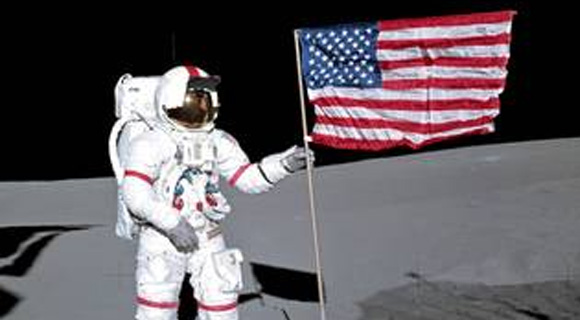NASA: Apollo 14 Demonstrated Spaceflight Challenges Are Solvable
By Space Coast Daily // February 8, 2016
'It's been a long way, but we're here'

(NASA.gov) – “It’s been a long way, but we’re here,” said Apollo 14 commander Alan Shepard as he stepped from the lunar module, or LM, onto the regolith of the moon’s Fra Mauro highlands.
When Apollo 14 touched down on the moon on Feb. 5, 1971, it was more than a 240,000-mile trip – it was a hard-fought return to flight for NASA’s Apollo Program and America’s first person in space.
Fra Mauro had been the intended landing site for Apollo 13 in April 1970. However, that mission became a struggle to safely return the crew when their Apollo spacecraft was crippled by an oxygen tank explosion.
Two days after the April 11, 1970 launch of Apollo 13, with the spacecraft approximately 205,000 miles from Earth, the astronauts heard a “loud bang.” One of two electricity producing fuel cell oxygen tanks in the service module had exploded. Damaged Teflon insulation on the wires to the stirring fan inside oxygen tank No. 2 allowed the wires to short-circuit and ignite the insulation.
The lessons learned from the lunar landing program now are helping the agency pave the way for the journey to Mars. As was the case during Apollo 14, NASA experts already are at work solving the challenges for human missions to the Red Planet.
In the nine months following Apollo 13, several modifications were made to the service module electrical power system, including redesign of the oxygen tanks and addition of a third tank.
After becoming the first NASA astronaut to travel in space on May 5, 1961, Shepard was grounded in 1964 by Ménière’s disease, a disorder of the inner ear that can affect hearing and balance. But, like NASA solving the problems posed by Apollo 13, Shepard found a way back.
A U.S. Navy aviator and one of the original Mercury Seven astronauts, Shepard’s condition prevented him from flying one of the Gemini missions. After surgery, however, he was returned to flight status. At age 47, Shepard would be the oldest space flyer to date and the only Mercury astronaut to walk on the moon.
Speaking about Shepard before the Apollo 14 flight, Kennedy Director Kurt Debus praised America’s first astronaut for his efforts to return to flight status.
“He’s an expert pilot and flier and he’s working very hard preparing for this mission,” Debus said.
“I’m happy he’s getting the opportunity to go to the moon. I envy him.”
Joining Shepard were two first-time flyers from NASA’s fifth groups of astronauts, U.S. Air Force pilot Stuart Roosa, serving as command module pilot, and Naval aviator Edgar Mitchell, lunar module pilot.
Apollo 14 launched on a nine-day mission Jan. 31, 1971. Once in Earth orbit, Roosa commented that the crew was “thoroughly impressed” by the performance of the Apollo Saturn V vehicle that was assembled and launching from the Florida spaceport.
Soon after liftoff, though, the mission hit its first “bump in the road.”
After one and a half orbits of the Earth, the Saturn V third stage was fired a second time to boost Apollo 14 on its path to the moon. Roosa separated the command-service module, or CSM, – named Kitty Hawk — from the upper stage to turn around and dock with the lunar module, Antares.

The CSM had difficulty docking with the LM. Several attempts to dock took place for 1 hour and 42 minutes. At that point Mission Control recommended Roosa hold Kitty Hawk against Antares using its thrusters, then the docking probe would be retracted, thus triggering the docking latches. This approach worked.
Apollo 14 arrived in lunar orbit on Feb. 4. The next day, Shepard and Mitchell boarded Antares and separated from Kitty Hawk in preparation for the landing. Soon after, the LM developed a problem.
First, the lander’s computer received an “abort” signal from a faulty switch. If the problem recurred after the descent engine began firing, the computer would respond as if the signal was real and initiate an automated abort. The ascent stage would separate from the descent stage and the LM would return to orbit.
NASA and the software experts at the Massachusetts Institute of Technology scrambled to find a work-around. They decided that the solution would involve reprogramming the Antares computer flight software to ignore the erroneous signal. The software modifications were radioed up to the crew. Mitchell entered the changes just in time, allowing the crew to be given a “go” to begin the powered descent.
CLICK HERE FOR MORE INFORMATION
















